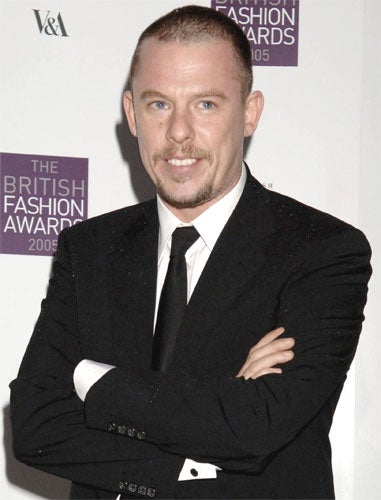Alexander the great's show must go on

The smoky aroma of Diptyque Feu de Bois filled the air as guests filed into an elegant townhouse in the 8th Arrondissement yesterday to view the collection that Alexander McQueen started but never lived to complete.
This was far from the grand-scale performances for which the designer was famed. Instead, and out of respect for both this man and his work, clothes were presented to small groups of visitors throughout the day, all of whom took their seats on muted gold blocks and accompanied by a soundtrack courtesy of the flame-haired opera singer, Simone Kermes. McQueen was listening to her arias while he worked on this collection in the weeks before he died.
The designer had been inspired this time around by Byzantine art, the carvings of Grinling Gibbons, and Old Master paintings and altarpieces, including, in particular, works by Jean Fouquet, Sandro Botticelli, Stephan Lochner, Hans Memling, Hugo van der Goes, Jean Hey and Hieronymus Bosch. This was quintessential McQueen territory, exploring the sublime and the macabre, the light and the dark, and religion too.
Let's not forget that McQueen's was the hand behind collections entitled both Dante – wickedly sharp violet silks and torn black lace, shown in an 18th-century church in London in the mid-1990s – and Joan – McQueen's embodiment of the martyr took her place on his catwalk at the end of that decade dressed in fire-red sequins and surrounded by a circle of fire.
On this sad occasion, however, the ideas that preoccupied the designer were treated in a more gentle and reverent way. While each of the 16 patterns shown had been cut by McQueen himself, it was left to his team, many of whom had collaborated with the designer for 15 years, to fit and finish the work. They did so with love and sensitivity – all the while living up to the ambitious technical expertise – and with just a hint of the underlying anarchy that drove the designer throughout his career.
And what clothes these were. Exquisite gold bullion hand embroideries made their way across gently structured top halves cut close to the body that morphed effortlessly into sweetly puffed skirts or more fluid, floor-length, designs. Byzantine tigers and Tudor Roses appeared on the finest jet black and cardinal red silks. Draping revealed gold-tipped feathers peeping from the hemlines. Here too was the Madonna whose draped robes, the colour of stone, were extended into the folds of a skirt.
McQueen's love affair with the engineered print in this instance reached its most pioneering conclusion as some of the greatest works of art in history were captured digitally then woven into precious jacquards, each entirely unique and wrapped around the body in an ever more accomplished way.
Every piece here was painstakingly worked – no two were the same. Jewelled gold thread glories adorned models' throats and delicate angel wings enveloped their arms and shoulders as the proceedings became increasingly ethereal and, at times, ecclesiastical also. Even the shoes – featuring gilded, hand-carved tangled ivy, acorns and broken skulls, alabaster angels and more – will go on to become treasured artefacts.
In the end, this was a heartbreakingly beautiful and perfectly judged tribute to one of the greatest talents the fashion industry has known, realised by a tightly knit and gifted group of people who have protected his name and what it stands for since he started out.
"All the patterns in this collection were cut on the stand by Lee Alexander McQueen," the show notes read. "Each piece is unique, as was he."
Join our commenting forum
Join thought-provoking conversations, follow other Independent readers and see their replies
Comments